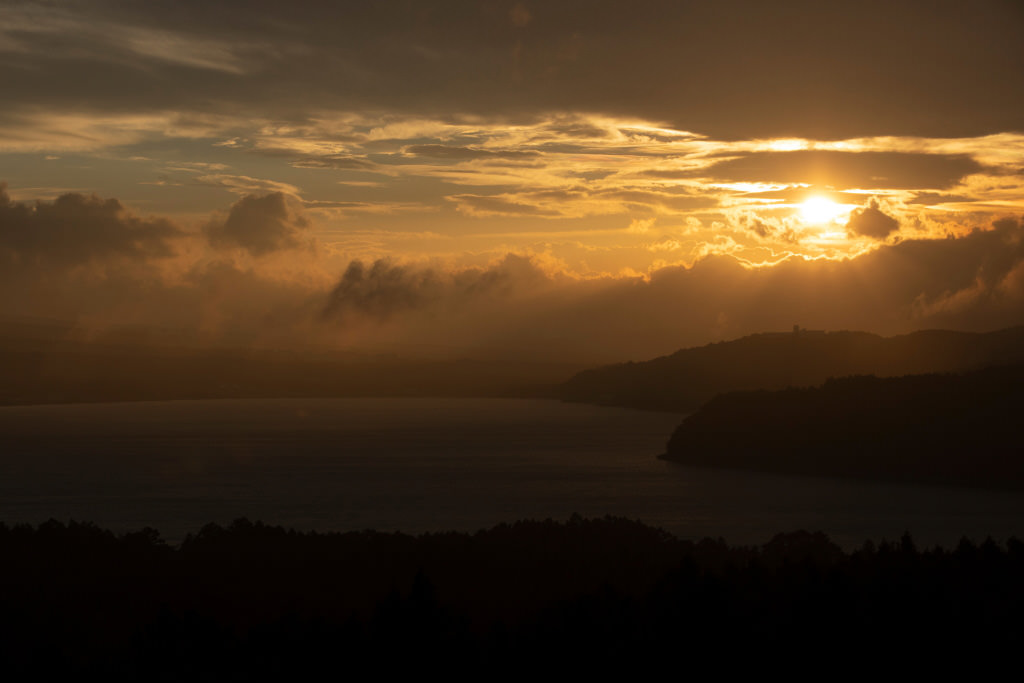Released 12 years after its predecessor’s debut, Canon’s new EF70-200mm f/4L IS II USM lens boasts 5-stop image stabilisation and excellent performance in backlight. How does it hold out? See for yourselves in this series of landscape photos shot with this telephoto zoom lens. (Reported by: GOTO AKI)

What you need to know about this lens
1. It is the first Canon lens to offer 5-stop image stabilisation

Stable images even when shot at 1/100 sec, by hand using the telephoto end
EOS 5D Mark IV/ EF70-200mm f/4L IS II USM/ FL: 200mm/ Shutter-priority AE (f/5.6, 1/100 sec, EV-0.7)/ ISO 400/ WB: Manual
The EF70-200mm f/4L IS II USM not only boasts the most powerful in-lens image stabilisation (IS) function on a Canon lens, it also comes with 3 different IS modes to cater to both panning shots and sports photography. The above image was shot by hand using the 200mm telephoto end. With such sharpness, one can’t help but feel encouraged to take more handheld shots of the water flow.
2. Its circular aperture produces beautiful bokeh even at narrower aperture settings

Beautifully round bokeh circles, even at f/8
EOS 5D Mark IV/ EF70-200mm f/4L IS II USM/ FL: 200mm/ Aperture-priority AE (f/8, 1/640 sec, EV-2.0)/ ISO 1600/ WB: Manual
This was shot in backlight, where sunlight seeped between the leaves of the trees in the forest. There was hardly any ghosting or flare. As the edges of the aperture blades are not obvious, the bokeh circles were round and beautiful even though I used an aperture that was a few stops narrower than the maximum (f/8 in the image above).
3. How it compares with Canon’s other 2 EF70-200mm f/4L lenses
Canon has 2 other EF70-200mm f/4L lenses:
- EF70-200mm f/4L IS USM (the predecessor of this lens)
- EF70-200mm f/4L USM (the non-IS version)
The following table compares the three. You can see that the EF70-200mm f/4L USM has the advantage in terms of aperture blades and image stabilisation effect.

Learn about the development history of Canon’s classic f/4L zoom lenses in these articles:
How Well Do You Know Your f/4L Zoom Lenses?
The Little-Known History of Canon’s f/2.8L and f/4L Zoom Lenses
Field testing the lens
Location: Fuji Five Lakes
Weather: Cloudy with occasional sunlight
Lighting conditions: Relatively poor
The true power of 5-stop image stabilisation
The EF70-200mm f/4L IS II USM is an improved version of the EF70-200mm f/4L IS USM, released 12 years ago and widely-acclaimed for its depictive performance. As a landscape photographer who often shoots handheld, I was looking forward to trying out the 5-stop image stabilisation on the lens.
The below image was shot by hand in the dim forest on a cloudy day. At ISO 1600, the shutter speed was around 1/50th of a second, which was a little slower than what you would expect from a telephoto zoom lens.

EOS 5D Mark IV/ EF70-200mm f/4L IS II USM/ FL: 70mm/ Aperture-priority AE (f/5.6, 1/50 sec, EV±0)/ ISO 1600/ WB: Daylight
Using IS Mode 1 while shooting through the viewfinder prevented camera shake, resulting in a tack sharp shot with the trees were all frozen in motion. By keeping the tree trunks in the background in focus, I hoped to achieve the visual effect of gazing through the rows of trees.
The reassurance of being able to capture a tack sharp image of the scene, down to the details with no subject blur, is a major advantage. Instead of constantly playing back images to check them for camera shake, I felt that could now focus my attention on releasing the shutter in time to capture changing lighting conditions. Even if the shooting conditions don't require a high shutter speed, the lens still offers a broad range of creative expression: It easily captured high-key images that had mostly white or light tones.
Pairing the lens with a camera that has strong low-light performance, such as the EOS 5D Mark IV or EOS 6D Mark II, will ensure stress-free shoots, even when shooting in the early morning, evening or other dimly-lit times of the day.

EOS 5D Mark IV/ EF70-200mm f/4L IS II USM/ FL: 94mm/ Aperture-priority AE (f/11, 1/1,000 sec, EV−1.0)/ ISO 400/ WB: Daylight
The evening sun over Lake Yamanaka was intense, but the updated Super Spectra Coating (SSC) prevented flare and ghosting. Thanks to it, I could focus on observing the lighting and cloud movements to capture the perfect shot.
So much versatility, it was almost hard to believe that I was using just one lens
The shorter closest focusing distance (or minimum shooting distance; 1m compared to 1.2m on the EF70-200mm f/4L IS USM) provides a tremendous advantage: I could now easily photograph the plants and flowers at my feet from a comfortable standing position.
It was a joy to shoot with this lens, not just with the telephoto macro mode that provides up to 0.27 times magnification, but also with the beautiful bokeh effect. I especially liked its versatility—it sometimes felt as though I was using a few lenses instead of just one.

EOS 5D Mark IV/ EF70-200mm f/4L IS II USM/ FL: 70mm/ Aperture-priority AE (f/11, 1/1,600sec, EV−0.7)/ ISO 400/ WB: Daylight
These flowers were swaying slightly in the breeze. I moved close to them and shot them from the closest focusing distance. The details were well-captured at f/11 and a fast shutter speed. I dialled down the exposure compensation to EV-0.7 to deepen the dark areas and make the white flowers pop.
Yet another major improvement over the predecessor is the increase to 9 aperture blades. Shooting at 2 to 3 stops narrower than maximum aperture, my bokeh circles (see 3rd image from top) were still round with no visible edges, which gave the light a soft look.

EOS 5D Mark IV/ EF70-200mm f/4L IS II USM/ FL: 200mm/ Aperture-priority AE (f/8, 1/2,500 sec, EV−0.7)/ ISO 400/ WB: Daylight
This telephoto macro shot of a poppy bud was photographed from 1m away (the closest focusing distance). Even at f/8, the shallow depth-of-field at 200mm and the circular aperture worked together to create beautiful, creamy bokeh from the colours in the background.
Inherits the well-acclaimed capabilities of its predecessor and improves on it
I spend a full day shooting various subjects in the Mount Fuji area by hand with the EF70-200mm f/4L IS II USM.
After this day out, I could not help but feel that the EF70-200mm f/4L IS II USM had inherited its predecessor’s much-praised resolving power and strong ability to reproduce areas with high contrast.
The improvements to the lens have made it capable of clearer, better-lit depictions than anything that I had ever experienced.

EOS 5D Mark IV/ EF70-200mm f/4L IS II USM/ FL: 70mm/ Aperture-priority AE (f/4, 1/3,200sec, EV+0.3)/ ISO 400/ WB: Daylight
The images are well-resolved all the way from the maximum aperture of f/4, with lines depicted in fine detail. Putting Mount Fuji in focus and defocusing the plants in the foreground makes the image feel more life-like.
*This review was conducted with a trial model, which might differ from the retail mode in terms of external appearance and image quality.
SPECIFICATIONS
Lens construction: 20 elements in 15 groups
Minimum aperture: f/32
No. of aperture places: 9 (circular aperture)
Closest focusing distance: 1m
Max. magnification: 0.27x
Filter diameter: φ72m
Size: φ80 ×176mm
Weight: approx. 780g
Lens construction diagram

A: Fluorite lens
B: UD lens

Attached to the EOS 5D Mark IV

Lens Hood ET-78B (bundled)
Receive the latest update on photography news, tips and tricks.
Be part of the SNAPSHOT Community.
Sign Up Now!
About the Author
Born in 1972 in Kanagawa Prefecture and graduated from Sophia University and Tokyo College of Photography. Goto published a photo collection work titled "LAND ESCAPES" and is also actively engaged in works such as “water silence” an installation that merges photographs with videos.
A monthly magazine that believes that enjoyment of photography will increase the more one learns about camera functions. It delivers news on the latest cameras and features and regularly introduces various photography techniques.
Published by Impress Corporation



































